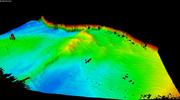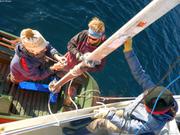Seabed mapping in uncharted areas to support ocean modelling, by
Combining climate change research and crowdsourced bathymetry, by Gabriel Joyal
The velocity and dynamics of tide-water glaciers are highly influenced by the submarine morphology near the terminus. Water depths at the glacier front and fjord bathymetry determine the circulation and stratification of ocean water within the fjord, and exchange of water across the continental shelf. These processes have a substantial influence on regulating submarine melt rates, retreat of glacier termini, calving of icebergs, and thus the contribution of tide-water glaciers to global sea level rise. Unfortunately, existing bathymetric data in the Canadian Arctic has large gaps, with the majority of glacial fjords completely uncharted, preventing numerical ocean models from accurately characterizing ocean circulation and the influence of the ocean on the mass balance of marine-terminating glaciers. In order to increase the spatial resolution of the bathymetry in uncharted fjords, there is a need to develop new mapping programs in the High Arctic, using acoustics or optics methods. To this day, large survey vessels (e.g. NGCC Amundsen) with deeper draft are not well suited for safe navigation in shallow uncharted near-shore areas, whereas satellite remote sensing technique give coarser resolution bathymetric data. For the last 3 weeks, with a multibeam echosounder, we collected data from Vagabond on the Eastern coast of Ellesmere Island during a seabed mapping dedicated research cruise. This innovative research program has been made possible through collaboration between academic researchers, R2Sonic LLC, and the Canadian Hydrographic Service. The results highlight the major role played by marine geomatics in climate change research. Moreover, the research-collected data shared with the federal authorities will allow Arctic charts updates, in a context of increased marine traffic and tourism in glacial fjords of the Canadian Arctic.


